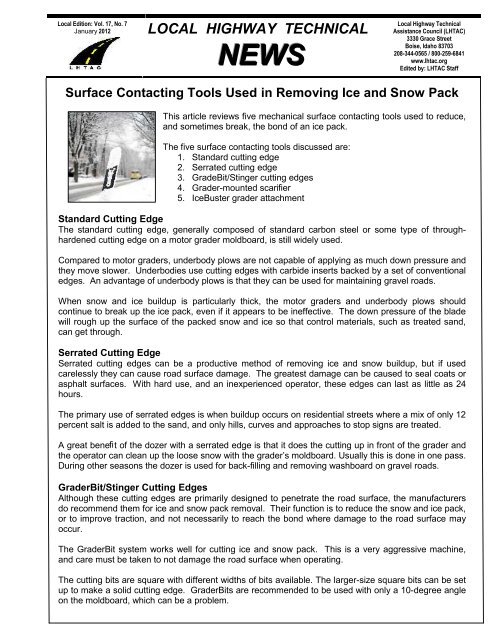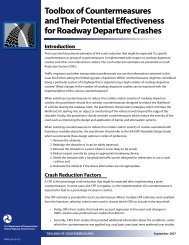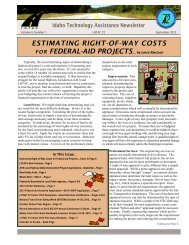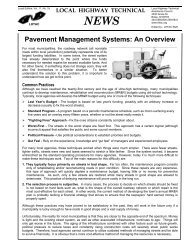Surface Contacting Tools Used in Removing Ice and Snow Pack
Surface Contacting Tools Used in Removing Ice and Snow Pack
Surface Contacting Tools Used in Removing Ice and Snow Pack
Create successful ePaper yourself
Turn your PDF publications into a flip-book with our unique Google optimized e-Paper software.
Local Edition: Vol. 17, No. 7January 2012LOCAL HIGHWAY TECHNICALNEWSLocal Highway TechnicalAssistance Council (LHTAC)3330 Grace StreetBoise, Idaho 83703208-344-0565 / 800-259-6841www.lhtac.orgEdited by: LHTAC Staff<strong>Surface</strong> <strong>Contact<strong>in</strong>g</strong> <strong>Tools</strong> <strong>Used</strong> <strong>in</strong> Remov<strong>in</strong>g <strong>Ice</strong> <strong>and</strong> <strong>Snow</strong> <strong>Pack</strong>This article reviews five mechanical surface contact<strong>in</strong>g tools used to reduce,<strong>and</strong> sometimes break, the bond of an ice pack.The five surface contact<strong>in</strong>g tools discussed are:1. St<strong>and</strong>ard cutt<strong>in</strong>g edge2. Serrated cutt<strong>in</strong>g edge3. GradeBit/St<strong>in</strong>ger cutt<strong>in</strong>g edges4. Grader-mounted scarifier5. <strong>Ice</strong>Buster grader attachmentSt<strong>and</strong>ard Cutt<strong>in</strong>g EdgeThe st<strong>and</strong>ard cutt<strong>in</strong>g edge, generally composed of st<strong>and</strong>ard carbon steel or some type of throughhardenedcutt<strong>in</strong>g edge on a motor grader moldboard, is still widely used.Compared to motor graders, underbody plows are not capable of apply<strong>in</strong>g as much down pressure <strong>and</strong>they move slower. Underbodies use cutt<strong>in</strong>g edges with carbide <strong>in</strong>serts backed by a set of conventionaledges. An advantage of underbody plows is that they can be used for ma<strong>in</strong>ta<strong>in</strong><strong>in</strong>g gravel roads.When snow <strong>and</strong> ice buildup is particularly thick, the motor graders <strong>and</strong> underbody plows shouldcont<strong>in</strong>ue to break up the ice pack, even if it appears to be <strong>in</strong>effective. The down pressure of the bladewill rough up the surface of the packed snow <strong>and</strong> ice so that control materials, such as treated s<strong>and</strong>,can get through.Serrated Cutt<strong>in</strong>g EdgeSerrated cutt<strong>in</strong>g edges can be a productive method of remov<strong>in</strong>g ice <strong>and</strong> snow buildup, but if usedcarelessly they can cause road surface damage. The greatest damage can be caused to seal coats orasphalt surfaces. With hard use, <strong>and</strong> an <strong>in</strong>experienced operator, these edges can last as little as 24hours.The primary use of serrated edges is when buildup occurs on residential streets where a mix of only 12percent salt is added to the s<strong>and</strong>, <strong>and</strong> only hills, curves <strong>and</strong> approaches to stop signs are treated.A great benefit of the dozer with a serrated edge is that it does the cutt<strong>in</strong>g up <strong>in</strong> front of the grader <strong>and</strong>the operator can clean up the loose snow with the grader’s moldboard. Usually this is done <strong>in</strong> one pass.Dur<strong>in</strong>g other seasons the dozer is used for back-fill<strong>in</strong>g <strong>and</strong> remov<strong>in</strong>g washboard on gravel roads.GraderBit/St<strong>in</strong>ger Cutt<strong>in</strong>g EdgesAlthough these cutt<strong>in</strong>g edges are primarily designed to penetrate the road surface, the manufacturersdo recommend them for ice <strong>and</strong> snow pack removal. Their function is to reduce the snow <strong>and</strong> ice pack,or to improve traction, <strong>and</strong> not necessarily to reach the bond where damage to the road surface mayoccur.The GraderBit system works well for cutt<strong>in</strong>g ice <strong>and</strong> snow pack. This is a very aggressive mach<strong>in</strong>e,<strong>and</strong> care must be taken to not damage the road surface when operat<strong>in</strong>g.The cutt<strong>in</strong>g bits are square with different widths of bits available. The larger-size square bits can be setup to make a solid cutt<strong>in</strong>g edge. GraderBits are recommended to be used with only a 10-degree angleon the moldboard, which can be a problem.
The St<strong>in</strong>gers can be used at more of an angle, but the bits have to be lubricated so they can turn <strong>in</strong> themount<strong>in</strong>g plate holes.In the summer a gravel ma<strong>in</strong>tenance grader can be equipped with a set of St<strong>in</strong>gers on the moldboard<strong>and</strong> used on gravel streets.Grader-Mounted ScarifierThe Grader-mounted scarifier is perhaps the bestknown tool <strong>and</strong> one that has been around for a longtime ( see Figure 1). However, it can be one of themost damag<strong>in</strong>g to road ways when remov<strong>in</strong>g snow <strong>and</strong>ice buildup.Dur<strong>in</strong>g construction season they become very valuable<strong>in</strong> penetrat<strong>in</strong>g up to 10 <strong>in</strong>ches <strong>in</strong>to material such as th<strong>in</strong>asphalt-surfaced roads <strong>and</strong> hard-packed base.In certa<strong>in</strong> cases, it can be a valuable tool forbreak<strong>in</strong>gthick snow <strong>and</strong> ice pack <strong>in</strong> valley gutters <strong>and</strong> dra<strong>in</strong>ageditches. Generally, its use is very limited <strong>in</strong> w<strong>in</strong>teroperations.Figure 1: A grader-mounted scarifier is generally apoor tool for break<strong>in</strong>g snowpack due to greatpotential for road surface damage.<strong>Ice</strong>Buster Grader AttachmentThe <strong>Ice</strong>Buster grader attachment is a fairly newapproach to remov<strong>in</strong>g ice <strong>and</strong> snow pack (see Figure 2).It can be attached to the front of a motorgrader on aquick hitch, on a front-end loader <strong>and</strong> on a scarifiermount beh<strong>in</strong>d the front wheels of a motor grader. Inaddition, smaller models are available for skid loaders.The <strong>Ice</strong>Buster is designed solely for ice <strong>and</strong> snow packremoval <strong>and</strong> causes very little pavement damage ( seeFigure 3).Figure 2: An <strong>Ice</strong>Buster mounted on a grader.However, the mach<strong>in</strong>e requires operator skill <strong>and</strong>responsibility <strong>in</strong> its ma<strong>in</strong>tenance <strong>and</strong> operation.Greas<strong>in</strong>g of the mach<strong>in</strong>e is very important. Thehydraulic lift on the attachment has enough downpressure to pick up the front of a grader. However thereis a variable down pressure adjustment <strong>and</strong> 500 psiseems to work best.Operat<strong>in</strong>g speed should not exceed 10 mph. Whenwork<strong>in</strong>g on residential streets with a front-mounted<strong>Ice</strong>Buster, the grader’s moldboard can be used to cleanup <strong>in</strong> one pass. Although the purpose of the <strong>Ice</strong>Busteris to break ice <strong>and</strong> snow pack, it can also be used toloosen recycled concrete <strong>and</strong> to pulverize asphaltchunks from th<strong>in</strong> pavement that has been broken up byscarify<strong>in</strong>g.Figure 3: Broken snowpack after us<strong>in</strong>g an<strong>Ice</strong>Buster. The <strong>Ice</strong>Buster works very aggressivelybut does little damage to the road surface.SummaryThis article is <strong>in</strong>tended to give you an overview of the use of surface contact<strong>in</strong>g tools for w<strong>in</strong>ter roadoperations. W<strong>in</strong>ter buildup of ice <strong>and</strong> snow is treated <strong>in</strong> many ways. The driv<strong>in</strong>g force <strong>in</strong> the decisionof what tool to use usually comes from policies, type of equipment available, permitted hours ofoperation, fund<strong>in</strong>g, traffic volume <strong>and</strong> reasonable safety for the driv<strong>in</strong>g public.Reference: UNH T2 Center, Road Bus<strong>in</strong>ess, Fall 2009, Vol. 24, No. 3






